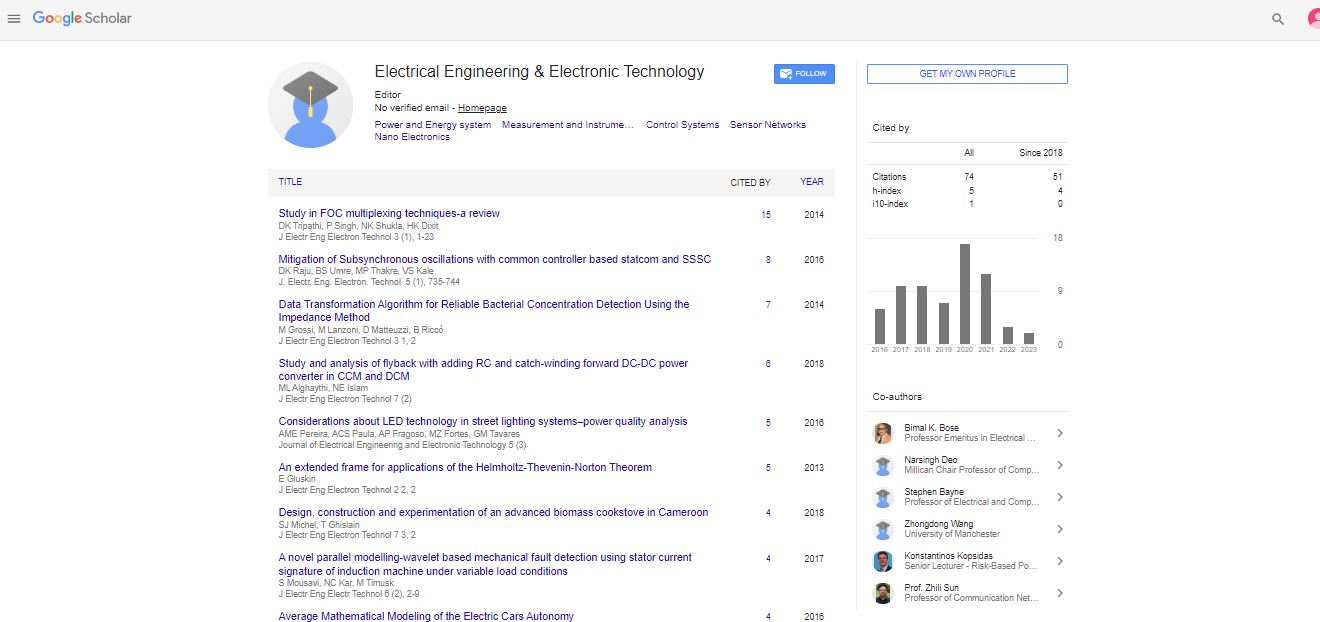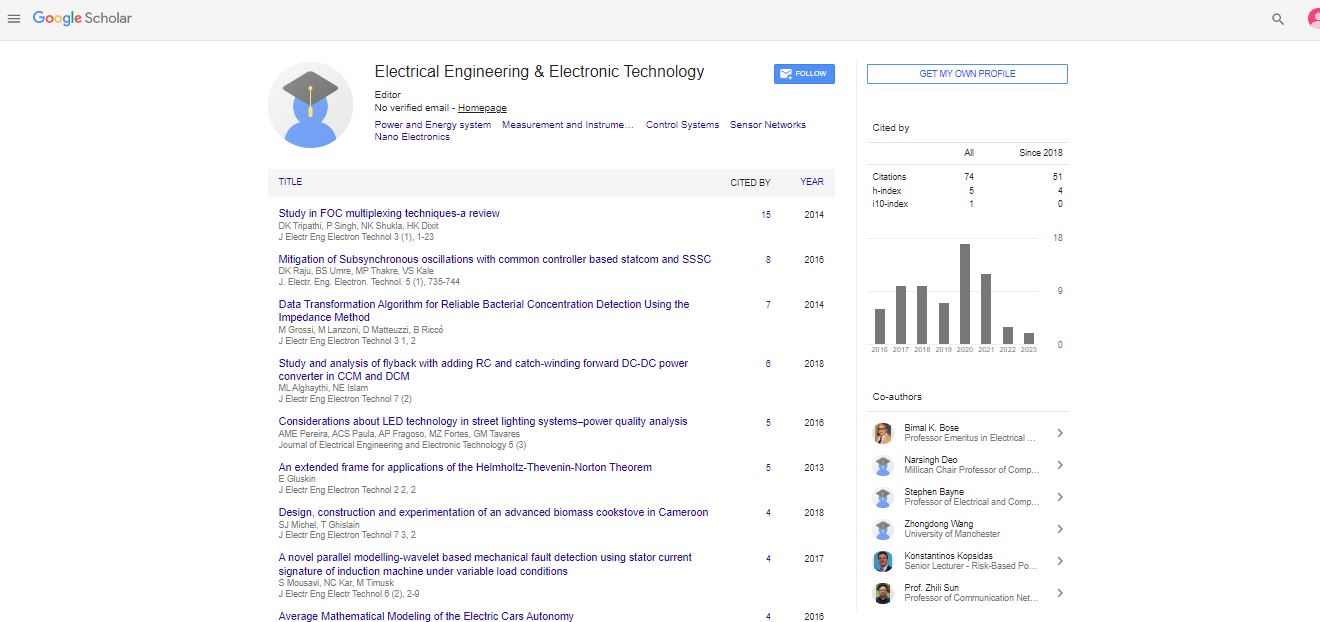Opinion Article, J Electr Eng Electron Technol Vol: 13 Issue: 4
Antenna and Propagation: The Cornerstones of Wireless Communication
Joe benjiman*
1Department of Electrical, Computer and Biomedical Engineering, West Virginia University Institute of Technology, Beckley, WV 25801, USA
*Corresponding Author: Joe benjiman,
Department of Electrical, Computer and Biomedical Engineering, West Virginia
University Institute of Technology, Beckley, WV 25801, USA
E-mail: benjimanj@gmail.com
Received date: 21 June, 2024, Manuscript No. JEEET-24-143442;
Editor assigned date: 24 June, 2024, Pre QC No. JEEET-24-14342 (PQ);
Reviewed date: 8 July, 2024, QC No. JEEET-24-143442;
Revised date: 15 July, 2024, Manuscript No. JEEET-24-143442 (R);
Published date: 22 July, 2024, DOI: 0.4172/2325-9838.1000981
Citation: Benjiman J (2024) Antenna and Propagation: The Cornerstones of Wireless Communication. J Electr Eng Electron Technol 13:4.
Description
In the constantly changing environment of wireless communication, antennas and propagation play important roles in ensuring effective and seamless information transfer. These fundamental components are central to the functioning of modern technologies, from smartphones and Wi-Fi networks to satellite communications. This article explores the essentials of antenna technology and signal propagation, highlighting their impact and innovations shaping the future of wireless communication.
The role of antennas
Antennas are devices that convert electrical signals into electromagnetic waves and vice versa. They act as the important link between transmission lines and free space, enabling wireless communication. Antennas vary widely in design and application, tailored to specific frequencies and requirements.
Types of antennas
Dipole antennas one of the simplest forms, dipole antennas consists of two conductive elements and is commonly used in radio and television broadcasting. Their design is straightforward but highly effective for various applications. Essentially half of a dipole antenna, monopole antennas is mounted over a conductive surface like a ground plane. They are widely used in mobile phones and vehicle communications due to their compact size and efficiency. Yagi-Uda Antennas: Known for their high gain and directionality, Yagi-Uda antennas are used where focused signal strength is needed, such as in television reception and amateur radio. Parabolic Dish Antennas: These antennas feature a dish that focuses signals to a narrow beam, making them ideal for satellite communications. Their high gain and precise directionality are important for long-distance communication.
Indicates how well an antenna focuses energy in a particular direction compared to a reference antenna. Higher gain antennas are used for long-distance communication where signal strength needs to be maximized. Refers to the range of frequencies over which the antenna operates effectively. Wider bandwidth allows the antenna to support multiple communication channels and applications. Describes the orientation of the electromagnetic wave’s electric field. Proper alignment of polarization between transmitting and receiving antennas is essential for optimal signal reception.
Fundamentals of signal propagation
Signal propagation encompasses how electromagnetic waves travel from the transmitter to the receiver. Effective communication system design relies on understanding these propagation mechanisms, as they impact signal strength, quality and coverage. Line-of-Sight (LOS) Propagation: Occurs when the transmitter and receiver are directly visible to each other. This method is ideal for high-frequency signals, such as those used in microwave and satellite communications, providing clear and direct communication. Ground wave propagation involves signals traveling along the Earth’s surface, effective for lower frequencies. This method is commonly used for AM radio broadcasts, extending coverage over large areas. Skywave propagation utilizes the ionosphere to reflect signals back to Earth, allowing long-distance communication. Shortwave radio often employs this method to reach distant regions by bouncing signals off the ionosphere. Tropospheric scatter relies on the scattering of signals by atmospheric layers, enabling communication beyond the line of sight. This technique supports long-range terrestrial microwave links and helps extend coverage.
Frequency higher frequency signals, such as those in the microwave range, have shorter wavelengths and are more easily absorbed by obstacles. Lower frequencies can diffract around obstacles and travel further. Weather conditions rain, fog and other atmospheric phenomena can attenuate or scatter signals, impacting propagation. This is particularly relevant in satellite and high-frequency communications. Terrain and obstacles natural and man-made obstacles can obstruct or reflect signals, leading to multipath propagation where signals take multiple paths to reach the receiver. Understanding these effects is important for designing effective communication systems.
Innovations and future trends
Recent advancements in antenna and propagation technologies are driving innovation in wireless communication: Multiple Input Multiple Output (MIMO) Technology utilizes multiple antennas at both the transmitter and receiver ends to increase capacity and improve signal reliability. MIMO is a cornerstone of modern Wi-Fi and 4G/5G networks, enhancing performance and connectivity. Beamforming is a technique that directs signals in specific directions rather than broadcasting them uniformly. Beamforming improves signal strength and reduces interference, optimizing the performance of wireless systems.
Smart Antennas incorporate adaptive algorithms to dynamically adjust radiation patterns based on the signal environment, enhancing coverage and efficiency. Metamaterials are engineered materials with unique properties that control electromagnetic waves in innovative ways. These materials are leading to advancements in antenna design and propagation control. Antenna design and signal propagation are vital to the success of wireless communication systems. As technology continues to advance, understanding these principles is essential for developing efficient, reliable and high-performing communication networks. Innovations in antennas and propagation techniques are not only enhancing current systems but also clearing the path for new applications and improvements. The ongoing evolution in these areas will ensure that our increasingly connected world remains seamless, efficient and well-integrated.
 Spanish
Spanish  Chinese
Chinese  Russian
Russian  German
German  French
French  Japanese
Japanese  Portuguese
Portuguese  Hindi
Hindi 
